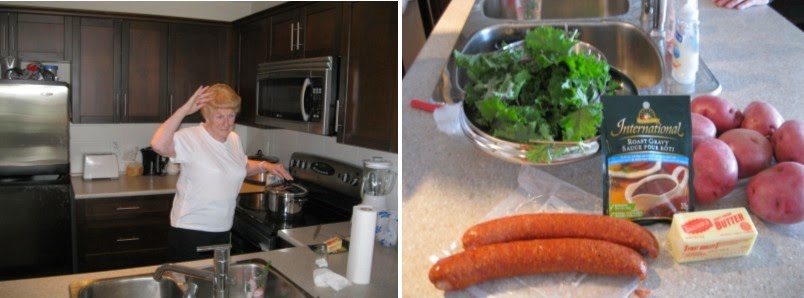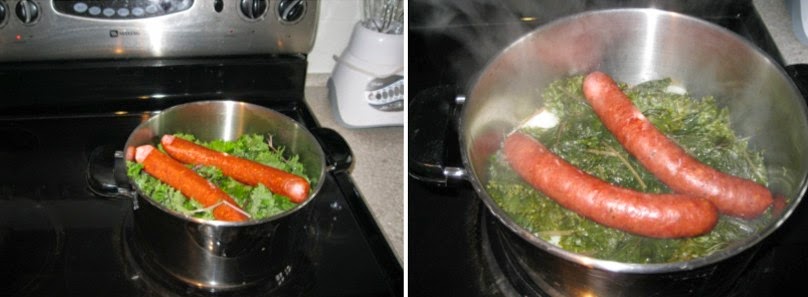.
.
.

Well, the Balcony of Eden has been chugging along for about two months now and it was time to harvest the kale, with the leaves having turned dark in colour. I had been picking through it already for several weeks, adding it into salads and making
two good-sized meals of Stamppot with the rest. Altogether I harvested 20 ounces of kale from that one container. I did a little bit of Googling and found that Kale
sells for $1.57/bunch, which is
about 130grams or 4 & 1/2 ounces - the next time I go to the grocery store I'll check the prices locally and then weigh it on
my scale at home. Quite obviously, this was a financial disaster, since I bought the kale as six pre-grown sprouts which cost a total of $8.94 plus 12% tax = $10.01 expenses. Take off the $7.07 profit I made by growing it and I have a net loss of $2.94 for my efforts. Uh oh! This is the road to bankruptcy! Quite obviously, one
must grow from seed or gardening is not cost-effective. At that rate, I won't even pay off the $12.84 (incl. tax) for the container and 30litre bag of soil in which I grew the kale in.
.

Heh, don't get me wrong - I'm not doing this to make money or to feed myself. This is more of an experiment than anything else, but I do want to monitor the expenses versus yields so I can become a more effective gardener. This was the first time I tried growing kale and it was a nice plant to grow - easy to care for; it looked wonderfully lush out on the balcony; and it tasted great. I'll plant kale again in the fall, since kale is one of those plants which can withstand frost and actually even tastes better after it has been exposed to frost. Of course, I will also grow it from seed next time, which will lower my expenses to around $2.00 - rather than the $10.01 I paid this time.
.

Also, the Mesclun Lettuce Mix had turned to flower and, like the Great Lakes Lettuce, was starting to look a little ratty. Both lettuces grew about as long as I expected them to - two months - before starting to turn. I harvested a total of 18ounces of salad greens from both pots, but like the kale I had bought them as pre-grown sprouts rather than from seed.
Leaf-Lettuce is worth $1.88/lb, so I produced $2.12 from an expense of $10.01 (incl. 12% tax), creating a net loss of $7.89. Therefore, coupled with
the Great Radish Famine of 2014, I am once again losing money and the Balcony of Eden is not only failing to make a profit, but is creating debt as fast the Federal Reserve and leading me into bankruptcy.
.
 |
| Left: Carrots & Cucumbers - Right: Radishes & Climbing Beans |
.

On the other hand, I now have several empty containers that aren't doing anything. When I harvested the radishes I made the mistake of doddling around for over a week before planting again in the empty container, costing me valuable growing time. I replanted radishes in the one pot (above right), since I want to try them again, and in the other pot - the one with the carrots (above left) - I planted some more carrot seeds in between the plants that didn't get demolished by trying to grow them together with radishes, as so many people recommend. No more radishes mixed with carrots for me, thanks! However, since radishes grow so quickly - about 3-4 weeks from seed to harvest - losing 9 or 10 days of growing time will cost me in overall production. The new radishes are popping up now and soon will need to thinned - this time with the proper spacing as said on the package - but if I hadn't been lazy about it, they would have been much further along by now.
.
I didn't make "the lazy mistake" with the kale and lettuce though, and had my seeds ready for planting as soon as I pulled out the old plants. I don't know how this will work, perhaps it's too late in the season already, but I planted ten nasturtium seeds in each of the previous lettuce containers. It says on the package that they should be planted indoors before transferring them outside two weeks after the last frost. Well, that time is well gone by, but the package also shows they grow until October, so I figured that's still quite a bit of time to have them. I made the mistake of planting a non-edible flower (Petunias - below left) to attract pollinators when I started the garden this year. From now on, nothing grown that isn't edible, I figure, so I wanted to try nasturtiums and see what they're like to grow.
.
 |
| Left: Wave Petunias -- Right: Potatoes |
.
In the container that used to have the kale (above right) I planted two new rows of lettuce. We certainly liked the Great Lakes Lettuce better than the Mesclun Mix, so this time I'm going to try a different variety - Grand Rapids Lettuce - which looks similar to the Great Lakes variety. Lettuce grows best in the spring and fall, so I don't know how well this is going to work heading into the heat of July and August, but time will tell. I will be planting more lettuce later in the year when the other crops are harvested and the weather cools again, and this way I can kind of get a feel for what it's like to grow lettuce from seed - as well as seeing the difference between growing them in a small container versus a large one. Since my potatoes have grown like bloody palm trees (above right), once the lettuce sprouts out of the soil I'll move the lettuce behind the shade of the potato plants to help keep them cool.
.
 |
| Tomatoes |
.
As for the rest of the garden, there are two beautiful tomatoes growing next to my chair (top right above) and a few more of the flowers are just beginning to turn into more tomatoes (bottom left above). The cherry tomatoes (bottom middle above) have flowered, but none of them have turned into tomatoes yet - they are certainly struggling compared to the full-sized ones, which is just the opposite of what I experienced for the past two years.
.
 |
| Top: Blueberries -- Bottom: Raspberries |
.
The raspberry plant (above - bottom left) is struggling more than the blueberry plant (above - top right), although there are a couple of raspberries on the one plant, and so far, I see no blueberries at all. I suspect that since these plants are perennials, they won't really produce until the next year - like the strawberries (below) which are now cranking out abundant, tasty little berries for me, of which I sampled my first few only a couple of days ago. Mmmmm... you know, homegrown strawberries are certainly smaller than store-bought ones, which are sometimes almost as big as an apple, but the taste of the homegrown strawberries is one hundred times better. I cringe to think of what kinds of genetically modified tinkering goes into those huge store-bought strawberries.
.
 |
| Yummy Strawberries |
.
 |
| Sweet Mix Peppers and Hot Mix Peppers |
.
The peppers which I transplanted from the window sill a few weeks ago are now taking root and growing to just where they are peeking over the rim of the pots. I had planted eight seeds and five made it, and out of those five, only one is struggling after the transplant (below right). Grow, my little babies, grow! You can certainly see the difference between topsoil-mix and potting-soil-mix in those pictures (below), can't you? The topsoil is full of little bits of bark and stuff, while the potting soil (the soil in the large containers) is nice and clean with no debris in it. I've read that potting soil is lighter than topsoil too.
.
 |
| Sweet Mix Peppers & Hot Mix Peppers |
.
The cucumbers (below - top left) have finally reached far enough out of the pot that I am able to start attaching them to the railing like the beans (below - top middle and right). I am surprised that so few cucumber plants sprouted from the amount of seeds I planted - I have enough plants, but didn't need to thin them at all, so it worked out good but I'll remember that for the future so I don't "under-plant" the seeds and have too few plants sprout up. The climbing beans as well came with only six seeds in the package, and of those six only four sprouted... and of those four that came up, two have really gone gang-busters while two have languished (below - bottom left and middle). However, those two that succeeded are
really going gangbusters! They climbed right up the railing lickety-split and and gave off several side-shoots that went nuts and grew about an inch a day as well, so the railing is starting to fill in now and I am able to kind of attach them here and there to fill in the bare spots. Next year I will plant more beans because it would have been nice for all six to have gone like those two. After all, how am I supposed to walk around naked on this balcony one day if I can't fill in my railing like a screen?
.
 |
| Top Left: Cucumbers -- Top Right & Bottom: Climbing Beans |
.
 I just read a neat write-up on alternative methods of gardening at Mobile Home Living. Check it out - there's lots of nifty pictures too, and we all know how much I love pictures.
I just read a neat write-up on alternative methods of gardening at Mobile Home Living. Check it out - there's lots of nifty pictures too, and we all know how much I love pictures.
































